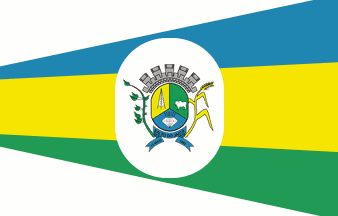 image by Dirk Schönberger,
19 March 2012
image by Dirk Schönberger,
19 March 2012Source: http://pt.wikipedia.org/wiki/Salto_do_Jacu%C3%AD

Last modified: 2020-08-08 by ian macdonald
Keywords: rio grande do sul | salto do jacuí |
Links: FOTW homepage |
search |
disclaimer and copyright |
write us |
mirrors
 image by Dirk Schönberger,
19 March 2012
image by Dirk Schönberger,
19 March 2012
Source:
http://pt.wikipedia.org/wiki/Salto_do_Jacu%C3%AD
The municipality of Salto do Jacuí (12,426 inhabitants in 2018; 50, 770 ha) is located 300 km north-west of Porto Alegre.
Ivan Sache, 4 August 2020
Five radiating broad stripes, white-blue-yellow-green-white, the two white
stripes only present as triangles in the upper and lower hoist bearing the
municipal arms in a round-cornered rectangle in the centre.
Dirk Schönberger,
19 March 2012
The
flag and arms of Salto do Jacuí are prescribed by Municipal Law No. 47
promulgated on 4 May 1984.
Article 2.
The coat of arms of the
municipality shall obey the following shape and description.
A Portuguese
shield, divided into three parts by three lines starting from its center, one
vertical line up to the shield's upper edge and two perpendicularly descending
lines, forming three irregular fields.
Dexter on a field or (yellow)
representing resources in energy, an electricity pylon. Sinister on a field vert
(green) representing the fields, a bovine representing cattle-breeding. In base,
on a field azure (blue), representing water resources, a gem symbolizing the
municipality's mining potential.
Beneath the shield a scroll azure inscribed
"SALTO DO JACUÍ 12 MAIO 1982", the date of political emancipation of the
municipality.
The shield surmounted dexter, tangentially to the scroll, by a
soybean plant vert and sinister, also tangentially to the scroll, by a wheat
plant or, which represent the municipality's main crops.
The shield
surmounted by a five-towered black mural crown.
Article 4.
The flag of
the municipality of Salto do Jacuí has for official colors white, blue, yellow,
green and white, arranged in this order and forming two right-angled triangles
and three fanning stripes, representing:
a) White, the people's message of
peace;
b) Blue, the community's confidence in a successful economical and
social future;
c) Yellow, the resources of agriculture and cattle-breeding;
d) Green, aspiration to a better understanding between world's peoples.
In
the flag's center shall be placed the coat of arms of the municipality.
Article 5.
The features of the flag obey the following rules.
I. The
flag's with is 12 units.
II. The flag's length is 18 units.
III. The blue,
yellow and green stripes fan from the third, fifth, sixth and ninth unit of the
hoist to reach the flag's fly.
IV. The two right-angled triangles formed by
the aforementioned stripes are white, with the hypotenuse starting from the
third upper and lower unit [...]
V. The central yellow stripe shall be broken
at the seventh unit by a white trapezoid of four units, up to the fly.
VI. In
the center of the white trapezoid is placed the coat of arms of the
municipality.
https://leismunicipais.com.br/a/rs/s/salto-do-jacui/lei-ordinaria/1984/5/47/lei-ordinaria-n-47-1984-institui-o-brasao-e-a-bandeira-como-simbolos-do-municipio-de-salto-do-jacui-e-da-outras-providencias
Leis Municipais database
Salto do Jacuí is self-styled the Gaúcha
Capital of Electric Energy.
The Passo Real power plant is fed with water from
the Passo Real Lake, the largest man-made lake in Rio Grande do Sul (area, 230
km2; length, 60 km; circumference, 610 km). Erected in 1968, the dam has a
length of 3,850 m and a height of 58 m; the power plant was inaugurated in
September 1973. The colossal building site is the origin of the modern
development of the town of Salto do Jacuí.
https://gauchazh.clicrbs.com.br/ambiente/noticia/2018/08/nas-entranhas-do-passo-real-ha-50-anos-uma-obra-mudava-a-historia-e-a-geografia-do-rs-cjkwyfstl024r01qksvr2488k.html
Zero Hora, 17 August 2018
Salto do Jacuí is also self-styled the
World's Agate Capital. Agate extraction in Rio Grande do Sul was initiated in
1824 by German immigrants. In 1870-1871, the German agate mines of
Steinkaulmenberg were closed, which widely opened the European market to
Brazilian gems, less expensive and easier to stain.
The Müller family started
agate extraction in Salto do Jacuí in the late 19th century, sending its first
shipment to Germany in 1910. Transformation technology was transferred from
Germany to Lajeado in the 1970s, then to Soledade.
https://radiogeracao.com.br/os-alemaes-e-as-pedras-preciosas-de-salto-do-jacui/
Radio Geração, 28 February 2018
Photos
https://www.facebook.com/PrefeituraSaltodoJacuiAdmin2017/photos
https://www.facebook.com/PrefeituraSaltodoJacuiAdmin2017/photos
Ivan Sache, 4 August 2020